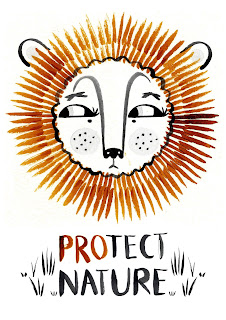Following the idea of creating imagery that could be used in an anti-hunting campaign, I created some ink and brush drawings. The protection of nature is what I ultimately want to promote so I thought it would be good to have some imagery of animals in their natural habitat - hence why I added a silhouette of a lion running. I want to include stand alone imagery as well as information in the pack - for now I am focusing on imagery and I will soon combine texts and relevant facts.
John Pickrell
for National Geographic News
for National Geographic News
March 15, 2007
Trophy hunting can play an essential role in the conservation of African wildlife, according to a growing number of biologists.
Now some experts are calling for a program to regulate Africa's sport-hunting industry to ensure its conservation benefits.
Private hunting operations in these countries control more than 540,000 square miles (1.4 million square kilometres) of land, the study also found. That's 22 percent more land than is protected by national parks.According to a recent study, in the 23 African countries that allow sport hunting, 18,500 tourists pay over $200 million (U.S.) a year to hunt lions, leopards, elephants, warthogs,water buffalo, impala, and rhinos.
As demand for land increases with swelling human populations, some conservationists are arguing that they can garner more effective results by working with hunters and taking a hand in regulating the industry.
Sport hunting can be sustainable if carefully managed, said Peter Lindsey, a conservation biologist with the University of Zimbabwe in Harare, who led the recent study.
"Trophy hunting is of key importance to conservation in Africa by creating [financial] incentives to promote and retain wildlife as a land use over vast areas," he said.
In an upcoming edition of the journal Conservation Biology Lindsey and an international team of colleagues call for a plan to increase the conservation benefits of sport hunting, including a certification program to more tightly regulate the industry.
"To justify the continued existence of [protected] areas in the context of increasing demand for land, wildlife has to pay for itself and contribute to the economy, and hunting provides an important means of achieving this," Lindsey said.
Hunting's Checkered Past
In order to be certified under Lindsey's proposed plan, hunting operations would have to prove their commitment to animal welfare, careful management of hunting quotas, wide-ranging conservation objectives, and the development of local communities.
"The time has come for greater scrutiny from scientists to promote maximum conservation benefits from hunting," Lindsey said.
"There should also be a greater effort from the hunting industry to self-regulate and ensure that unscrupulous elements are weeded out."
Trophy hunting has a bad reputation in the developed world, due in part to indiscriminate hunting by early European settlers, Lindsey observed.
But hunting has also been credited with facilitating the recovery of species, Lindsey's team argues in its paper.Reckless hunting resulted in the extinction of species such as the quagga (a cousin of the zebra) and led to the massive decline of others, including the elephant and black rhinoceros.
The southern white rhinoceros grew from just 50 animals a century ago to over 11,000 wild individuals today, because hunts gave game ranchers a financial incentive to reintroduce the animal, the authors write.
Trophy hunting has also driven the reintroduction of cape mountain zebra and black wildebeest in South Africa, Lindsey said.
Hunters typically take just 2 to 5 percent of males annually from hunted animal populations, he added, which has a negligible effect on the populations' reproductive health.






























